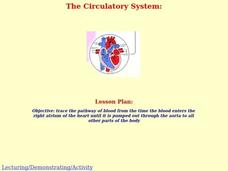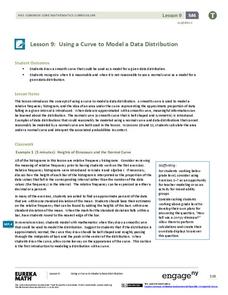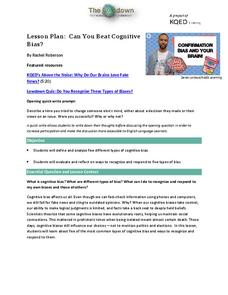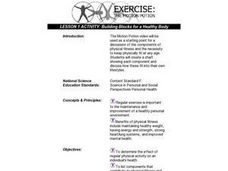Curated OER
The Circulatory System
Students follow the path of blood from its entrance into the right atrium of the heart until it leave through the aorta to the rest of the body. They study the heart's structure and how it pumps blood using the included activities. They...
Curated OER
Coastal Surveys
Students investigate the human impact on coastal land. In this coastal surveys lesson plan, students choose a coastal area and complete a survey sheet about the area. They choose a topic about a sea side village called Dunwich to prepare...
Curated OER
Spaced Out
Students are introduced to the space environment. This lesson covers the major differences between the environment on Earth and that of outer space and the engineering challenges that arise because of these discrepancies. In order to...
Curated OER
Classification of the Chemical Elements
Students construct a periodic table using felt strips as elements by arranging elements based on their characteristics. In this periodic table lesson plan, students place colored strips of paper that represent elements in the proper...
EngageNY
Algebraic Expressions—The Commutative and Associative Properties
Who says math is boring? Turn dry concepts like properties and vocabulary into an interesting lesson! Examine the commutative and associative properties of addition and multiplication using geometric reinforcement. Through collaboration,...
EngageNY
The Side-Angle-Side (SAS) and Side-Side-Side (SSS) Criteria for Two Triangles to Be Similar
Playing with mathematics can invoke curiosity and excitement. As pupils construct triangles with given criteria, they determine the necessary requirements to support similarity. After determining the criteria, they practice verifying...
EngageNY
The Distance from a Point to a Line
What is the fastest way to get from point A to line l? A straight perpendicular line! Learners use what they have learned in the previous lessons in this series and develop a formula for finding the shortest distance from a point to a...
EngageNY
Construct an Equilateral Triangle (part 2)
Triangles, triangles, and more triangles! In this second installment of a 36-part series, your young mathematicians explore two increasingly challenging constructions, requiring them to develop a way to construct three triangles that...
EngageNY
Solving Quadratic Equations by Completing the Square
Many learners find completing the square the preferred approach to solving quadratic equations. Class members combine their skills of using square roots to solve quadratics and completing the square. The resource incorporates a variety...
EngageNY
The Relationship of Multiplication and Division
Take any number, multiply it by five, and then divide by five. Did you end up with the original number? In the same vein as the previous lesson, pupils discover the relationship between multiplication and division. They develop the...
EngageNY
Using a Curve to Model a Data Distribution
Show scholars the importance of recognizing a normal curve within a set of data. Learners analyze normal curves and calculate mean and standard deviation.
EngageNY
Modeling with Quadratic Functions (part 2)
How many points are needed to define a unique parabola? Individuals work with data to answer this question. Ultimately, they determine the quadratic model when given three points. The concept is applied to data from a dropped object,...
Prestwick House
Vocabulary in Context: Inside the World of Wizards
Enter the world of Harry Potter and learn new vocabulary at the same time. A high-interest reading passage provides insight into the history of Harry Potter. Follow-up activities incorporate key vocabulary strategies, such as using...
Redefining Progress
Have and Have-Not
Is there a correlation between a country's wealth and the extent of its ecological footprint? What exactly constitutes an ecological footprint, and how does one country stack up against the rest? This is a unique instructional activity...
EngageNY
Converse of the Pythagorean Theorem
Discover a new application of the Pythagorean Theorem. Learners prove and apply the converse of the Pythagorean Theorem in the 17th lesson in a 25-part series. The examples ask learners to verify right triangles using the converse of the...
NPR
Can You Beat Cognitive Bias?
In a time of fake news, media manipulation, and Internet trolls, a resource equips learners with the tools they need to recognize and combat resources that are designed to appeal to our cognitive biases. Introduce learners to five...
Curated OER
You Must See It to Believe It!
Fifth graders participate in visualization exercises in order to improve their reading comprehension. As a class they listen to the teacher describe a setting and visualize the details, then read the first chapter of the book "Holes" by...
Curated OER
Exercising the Franchise! The Right to Vote
Pupils research Canadian election procedures, identify candidates and corresponding political platforms for current elections and hold mock elections. They develop a written report about a specific political party.
Curated OER
Building Blocks for a Healthy Body
Students watch a video and discuss the benefits of regular exercise. They use books, Internet sites and interviews with health professionals to develop a list of activities to develop physical fitness.
Curated OER
Shape and Space: Circles
Students create isosceles triangles. In this triangles lesson, students participate in a quick fire exercise with combinations of numbers totaling 180. Students complete a worksheet with several problems.
Curated OER
Making a Movie in our Mind
Learners participate in visualization exercises to create mental pictures as they read. They discuss silent reading techniques, and observe the teacher modeling how to visualize the beginning of the book Pippi Longstocking. In pairs they...
Curated OER
ANCIENT INDIA
Sixth graders engage in a variety of activities in order to study the culture of Ancient India. They read text in order to answer specific questions. Students make a crossword puzzle to review vocabulary among many other exercises in the...
Curated OER
Picture It!
Students participate in visualization exercises as a reading comprehension strategy. As the teacher reads a poem, the students visualize the setting, then read the poem "Daddy's Making Dinner" and create a drawing of what they visualize...
Curated OER
Salmon Smolt: Stella PC and Mac
Students investigate the Stella Smolts Migration Model and its use in previous simulation models to help managers deal with the many factors contributing smolts decline. They participate in an interactive exercise in the role of fishery...

























